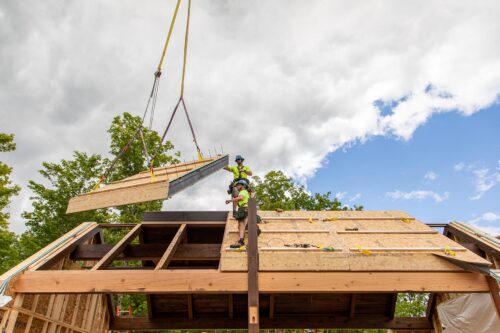
Report | 2023
The Hidden Climate Impact of Residential Construction
Zeroing in on embodied carbon emissions for low-rise residential buildings in the United States
New home construction in the US creates over 50 million tons of embodied carbon emissions annually, equivalent to the emissions from 138 natural gas–fired power plants or the yearly emissions from entire countries such as Norway, Peru, and Sweden. However, the sector has a unique opportunity to reduce tens of millions of tons of emissions and become a leading contributor to US climate targets, quickly and efficiently. Understanding and reducing overall climate impact requires paying attention to the upstream, or embodied, emissions that result from producing building materials such as concrete and insulation in addition to the downstream operational emissions from heating and cooling.
This report explores our current understanding of cradle-to-gate (CtG) embodied carbon emissions, otherwise known as up-front emissions from materials captured in lifecycle phases A1-A3, in new home construction and the building industry’s ability to mitigate these emissions. We demonstrate how this can be done without any negative repercussions for continuing efforts to bring operational greenhouse gas (GHG) emissions to zero, providing the market with clear directions for fast, practical, and cost-effective change.

The results of five previous studies that examined CtG embodied carbon emissions showed a surprisingly consistent average range of 150–210 kilograms of carbon dioxide equivalent per square meter of conditioned floor area (kg CO2e/m2 cfa). Applying the average CtG embodied carbon emissions results to the estimated construction in the United States each year indicates that structure, enclosure, and partition emissions from new homes may be 26–39 million tons CO2e annually.
The examined studies show that reductions of 30 to 50 percent can be demonstrated with commercially available, affordable, and code-compliant building materials. Builders and designers can immediately reduce the carbon footprint of new homes using existing material solutions without significant disruption to current practices by targeting just a few key material categories: concrete, insulation, cladding, and interior surfaces, which together typically represent more than 70 percent of the total emissions of new home construction. The scale of emissions reductions can increase to 140 percent with the use of a full range of available low-emitting substitute materials and carbon-storing materials entering the market.
Key Takeaways
There is a significant opportunity for climate mitigation with the reduction of cradle to gate (CtG) embodied carbon emissions from new homes and renovations.
Home builders can take immediate steps to achieve 30 to 50 percent emissions reductions at cost parity with currently available tools and materials.
Average CtG embodied carbon emissions for new low-rise residential homes are around 184 kg CO2e/m2, as determined from 921 model homes across the United States, Canada, and Europe. At an annual new construction rate of approximately 167 million m2, the potential carbon emissions impact of new home construction in the United States exceeds the equivalent of annual CO2 emissions from entire countries such as Bahrain, Denmark, and Ireland.
It is possible to build energy-efficient, healthy, and comfortable homes with both low operational and low embodied carbon emissions now. Embodied carbon emissions are becoming increasingly significant as operational GHG emissions continue to decline.
